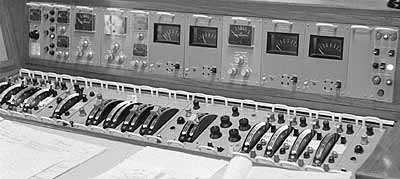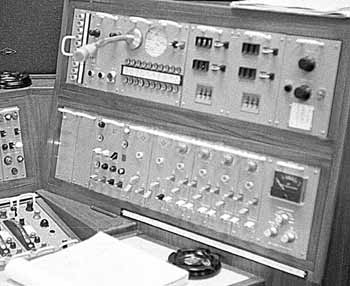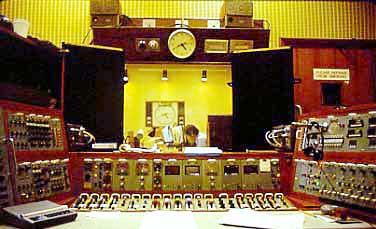In the cubicle the group faders were used to ride the levels of the studio
channels - this was the only design failure - you could not pre-lift any one
studio channel but had to wait for it almost to get to air and lift it with
the group. There were additional source faders in the cubicle of the 3 tape
machines (plus a cubicle cart) and 4 outside sources which had gain tweakers
and pan (PA8 297's). But each group of the 5 (carts, grams, mics and cubicle
tapes and outside sources) had access to limiters. They were delay line types
(AM6/11) and you could crush the sound really hard and still sound ok. There
were separate lims on the mic group, mixer group and repro which enabled fabulous
voice-over (again on a quadrant) control for auto gain-ducking (Noel Edmonds,
Terry Wogan) and great separation for telephone calls.
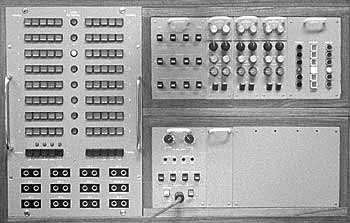
There was a telephone balance module which could be plugged to OS channels,
limited RSA (AM22/2 equalisers) facilities, again patchable, except for a
permanent one in each mic chain (DLT's setting is etched on my brain as half
top, one bass and 3 at 2.8). And of course network switching. Only six inlets
and six outlets on the relay matrix and it was very crude (PA8 320). The accepting
con placed his finger on the connect button and tannoyed to the releasing
con to "let it go". It was usually done after the junction with
the outgoing con having picked up the incoming one as a source. But it was
possible to drop any network into thin air by just pressing the release.
There were a few other bits and pieces in the cubicle such as GTS inserts,
OS control/cue line switching.
The desks were quite hissy but for ease of use and the sheer pleasure in moving
quadrant faders they were fab. There was also a plug-in sports mixer trolley
with another 12 outside sources intended for big OB operations. It could be
wheeled around and plugged into the cubicle desk but to my knowledge was never
used in anger.
Monitoring was usually on Spendor BC1s right in your face as there was no
room for distance listening. Later (as in this photo of Con D) the bi-amped
LS3/7 speakers arrived.
At one time Radio 1 used to relay Radio 2 from 7pm to 10pm (up to Sounds of
the Seventies when VHF switched to Radio 1). So one evening shift job was
to sit in Con B add 8dBs of compression and "monitor" the Radio
1 distribution or MW check receiver to make sure it didn't drop off! After
a supper break in the pub, it was sometimes a challenge to see how many of
the type D modules could be pulled out before the distribution went off. We
were able to get it down to 5 remaining - but then when your monitoring module
was out how could you be sure you were still on air? Intercom howling was
another great pastime. Ring your colleague in sleepy old Radio 3 on his PBX
phone and when he answered hold the phone to the tech intercom mic and press
talk. The resultant howl/whistle/roar was very satisfying.
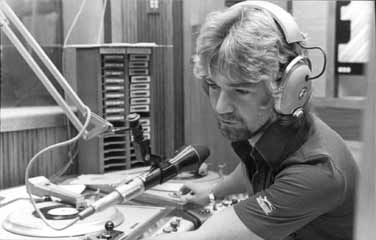
In fact there were many japes to be had. I recall placing a talkback speaker
in the desk below Noel's feet and occasionally feeding a low dog bark off
the cubicle cart to it. Keeping a straight face was the hard bit. And the
all-time classic was to pre-record to tape one of Noel's records and play
it in as he started the gram deck (having closed the gram group). The auto
voice-over convinced him it was the record playing. After a minute I walked
in and lifted the needle off the deck. Of course the output was from the tape
and continued but he actually fell off his chair.
Shipping forecasts on 1500m LW were tricky if you were in Radio 2. There was
a system to split the DJ desk away from the main output onto the STB output.
So on an agreed pause the T.O. played a pre-rec 5 minute filler tape to VHF
while the announcer warbled away on longwave. All would be rejoined on the
GTS, but you had to keep your wits about you. The trickiest was a hot switch
of VHF during the pips when many a time it was forgotten that Radio 1 pips
were plus 8dB and Radio 2 ones only plus 4. So the last few pips suddenly
dropped or rose in level.
The other great use of the type D cubicle desk was that with a sleeping bag
the footwell made a great bed for nightshifts!
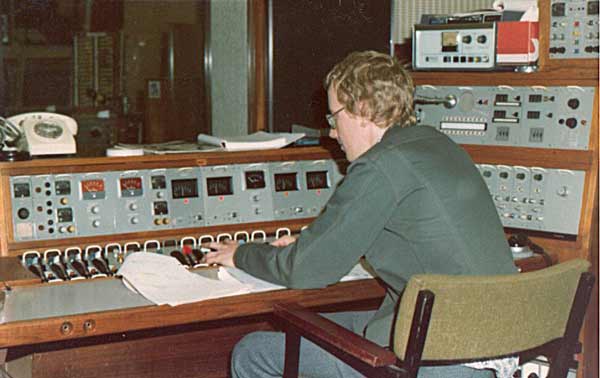
Phil Hughes in Con E.
